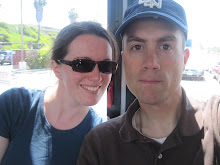Church Envy. Under his heading "Liturgical Longings", Mr. Hagopian describes the converts' "hysteria" over what they perceive to be beauty (even sublimity) in the mass. A liturgy-is-beautiful claim fails to be a persuasive ground for conversion in several ways.
First, for many people taken in by this liturgical luster, "it is the kind of worship with which they have grown up." But "just because we are accustomed to something, just because we have a fondness for something, or just because we may long for the good ol' days, doesn't mean that what we are accustomed to, fond of, or long for is necessarily right." I completely agree, but this was not the claim of the converts (that they were seeking to return to the familiar). Rather, the claim was that the liturgy and the mass have inherent beauty, and as Mr. Hagopian does not deny this here, I presume the point remains unmoved.
Second, he observes, Neocatholics claim to be drawn to the liturgy because "the liturgy, for the most part, is the same no matter which Catholic church a parishioner attends." But "[s]ameness, however, is no guarantor of propriety. After all, something can be the same and yet be erroneous...". I completely agree, but I doubt that any converts were arguing that the liturgy is true because it is the same everywhere. My observation has been that converts claim, rather, that the Catholic Church's liturgical practices are beautiful in part because they are consistent across the Church. That there is a laudable quality to Christians worshipping in unity remains unmoved.
One argument briefly noted, and a decent one, is that love of liturgy is no reason for conversion, because other churches have liturgy too (he noted the Orthodox, Episcopals and Lutherans). I wonder though how Mr. Hagopian feels about those other bodies, or why he would be more opposed to a brother converting to Catholicism over Orthodoxy (or Episcopalianism!).

Under the heading "All That Glimmers", Mr. Hagopian describes how several converts were taken in by the physical beauty of Catholic church buildings (columns, stained glass, candlelight and all). He notes a common claim of metaphysical experiences along the road to conversion. But these experiences "do not prove that Catholicism is true". Also, they do not prove Protestantism false, as the liturgical Protestant denominations have qualities of physical beauty as well.
This argument confuses the burdens of proof. Indeed the claimed beauty of Catholic services or buildings does not prove it to be true, but I have never heard any convert claim that is was such a proof. I have heard them say that this beauty drew them in enough to consider the Catholic theological claims of truth. Those claims are what should be weighed when deciding whether Catholicism is true or false. When tracing the Church from the time of Christ and the Apostles to the present, the burden is on the believer to prove the point at which Catholicism became false, and not the opposite. If one must prove Catholicism remained true at each moment in history, then one is facing a perpetual presumption that it is false. Such a standard both leads to fallacy and is uncharitable.
Mr. Hagopian considers other reasons for conversion, but I will stop here to mitigate the risk of going on for too long. I believe we can learn from his discussion of conversions (which is implicitly a portion of a larger discussion on ecumenicity) that default positions and burdens of proof can wreak havoc on the goal of unity. It is so easy to lay waste to an opponent by setting a high bar of proof against his position, and asserting that he has not met it (in our own judgment). I believe that this does not meet the charitable standard of fraternal conduct by which we are bound to treat one another in the Body of Christ. I see this failure on all fronts, and pray that I could avoid this myself in the future (for I have certainly failed in the past).


2 comments:
Mr. Hagopian's arguments are similar to the "smells and bells" criticisms Orthodox converts often face. They're basically throw-away arguments to detract from their real frustration; "what do my bare white walls and worship bands teach me about The Church?" Hagopian must somehow verbally bridge the gap between heaven and earth while simultaneously asserting that Orthodox and Catholic believers maintain that gap through their "faulty" doctrines. The only problem is that in both communions the iconography and liturgy both verbally AND visually affirm that which Mr. Hagopian is left trying to explain through a 16th century novelty.
As a convert to Catholicism, from being a Protestant, the liturgy was part of the conversion but not for the reasons listed here.
I was tired of how worship services, especially in the evangelical world, were driven around being entertaining and exciting. The liturgy of mass, instead of being entertaining, requires a willful decision to participate.
I feel the spiritual experience during mass is reflexive, I get out of it what I bring in. Instead of being distracted in a loud rock-concert like worship, I am brought to a place of quite where I become aware the current state of my own spirit. Actually, it is very frequently uncomfortable, but always edifying.
It is this focus on the mystical, rather than the sensational, that I believe gives credit to the liturgy of the Catholic Church.
Post a Comment